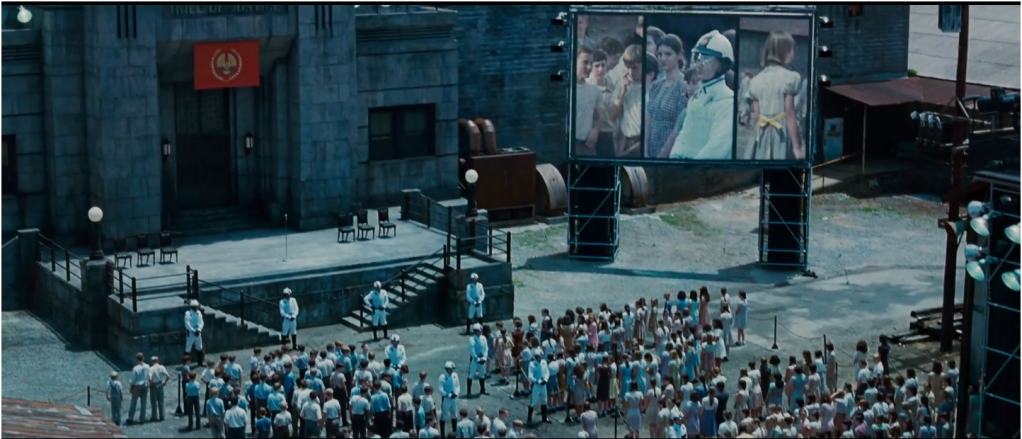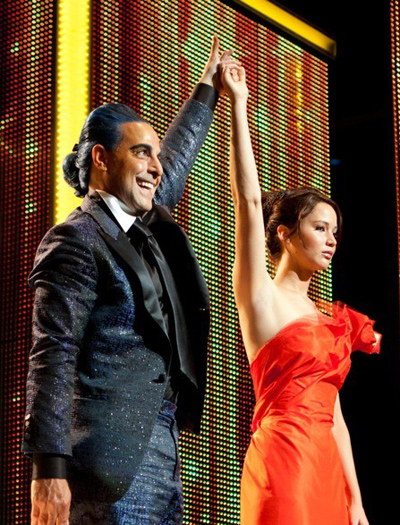The Hunger Games (2012) Review
Adapting a book into a film is probably one of the hardest and most thankless jobs in Hollywood, because no matter what you do and no matter how faithful you try to make it, there will always be something that pisses the book's fanbase off, especially with a book as popular as The Hunger Games. That being said, there is a lot about The Hunger Games that would be extremely difficult to convert to the screen (such as some of the gorier demises and some of the intricacies of the characters and their interpersonal relationships, as well as some minute details that were quite frankly necessary to cut out). Plus, the filmmakers had the difficulty of turning decidedly R-rated source material into a PG-13 film, so as to play to their target audience.
Before I say anything, I will say that those who haven't read the source novel by Suzanne Collins (who also co-authored the screenplay) as well as the other two books in the series should read them immediately. Together, they make up what is likely the finest young-adult book series ever written. They shouldn't be too hard to find right now, the bookstores are teeming with them. But this isn't a review saying what I like about the books, it's about the film and as adaptations go, The Hunger Games is one of the better ones I have recently seen and it is sure to be a highlight in the films of the year and a highlight in my favourite films of 2012.
The film captures the essence of Suzanne Collins' books perfectly, though there are some things that get lost in translation, some of the intricacies of the book that would be near-impossible to convert perfectly to film. Sadly, the film suffers for it, but I can't deny (nobody can, really) that The Hunger Games is a solidly made film and the first good blockbuster of the year. The film has a great story (naturally, considering the story of the books) and said story is backed up by excellent acting, superb direction from Gary Ross (the director of Pleasantville, one of the most underrated films of all time, doing his first film since Seabiscuit), and magnificent visuals. This is the Hunger Games film I wanted to see, and it lived up to the hype in every way, flaws and all.
 |
| Jennifer Lawrence as Katniss Everdeen |
The story proper is about Katniss Everdeen (Jennifer Lawrence) a seventeen-year old living in District 12, who has been forced to support her family (by hunting and selling/trading her game in the black market) since her father's death in a mine explosion. The film starts on Reaping Day, and this also happens to be the first year that Katniss's little sister Prim (Willow Shields) has her name entered in the lottery. Naturally, through the cruel nature of a random lottery, Prim's name gets picked and desperate to preserve her sister's safety (seeing as Prim likely would not make it far in the Games), Katniss volunteers in her place.
 |
| An absolutely perfect scene. The camerawork, the set design, the lack of music, the atmosphere, Elizabeth Banks bouncing around with an inappropriate amount of joy, all of it was just perfect. |
 |
| Josh Hutcherson as Peeta Mellark, the male tribute from District 12 and one of the lower rungs on the forming love triangle. Which, according to some fans, is all he is. Which is why I dislike the fandom. |
This element of the book, to me, is played out much better in the film, because you get to see the Games from a more global perspective in the film. The novel is a character study set entirely to the point of view of Katniss, and her point of view is still present in the film, but the film has scenes without her, like the many scenes in the gamemaker's room, the intermittent commentaries from Stanley Tucci and Toby Jones (handled exactly like a sports commentary), and there are also some incidents where you view some of the things from the book from a different perspective (one which I won't spoil). Some may say that the scenes felt a bit tacked on to add running time, but I disagree, especially since it added to the characterization of several characters that don't do that much in the book.
 |
| The very character who represents just how unfair the idea of the Hunger Games really is, and the film's most wasted commodity. Amandla Stenberg as Rue. |
However, despite the strength of the source material, the film's real strength, when you pick it apart, is the series of fine performances from one of the best ensemble casts in recent memory. First of all, the film would not be as great as it is without the phenomenal leading performance of Jennifer Lawrence as Katniss Everdeen, which is potentially worthy of another Oscar nomination. Lawrence embodies the character perfectly, easily one of the most coveted roles since Lisbeth Salander and Scarlett O'Hara. Knowing the book well, I'm glad they cast older as opposed to younger (I know a lot of younger actresses tried out for the role, like Chloe Moretz and Hailee Steinfeld). Moretz would be too young, and Steinfeld would have been too steely. Lawrence captured just the right amounts of stoicism and vulnerability, and words cannot describe how perfectly she captured the character. She and this franchise will go far.
 |
| The girl on fire who set the world on fire. Also with Stanley Tucci, who plays one of the most awesome characters. |
Outside the main three, there are a series of fine supporting performances from the likes of Woody Harrelson, Elizabeth Banks (though she is practically unrecognizable), Lenny Kravitz, Donald Sutherland, Stanley Tucci, and Wes Bentley in a standout performance as Seneca Crane, the head gamemaker. In fact, Bentley delivered one of my favourite performances in the film, which I talk about in detail in the following paragraphs. They all embody their characters perfectly, though in my first viewing, I felt like Harrelson played Haymitch a bit too drunkly. However, that changed upon my second viewing, so I suppose you could say that his performance grew on me.
 |
| One of the best. Needless to say, I can't wait until he gets developed in the later films |
The film also has a fantastic young supporting cast (the tributes, namely) of mostly unknown actors. Willow Shields does a decently good job as Prim, though her job is mostly to cry and act scared (reasonably so, she's a child who is picked for the Games her first year). The featured tributes (from District 1, 2, and 11 mostly) all give great performances, the strongest performers probably being Alexander Ludwig as Cato (whom I also talk about in detail) and Amandla Stenberg as Rue, who doesn't get nearly enough screentime but gives a great performance nonetheless (and a powerful added scene near the middle of the film kind of makes up for that). However, each of the named tributes gets their moment in the sun, and they each take advantage of it, namely Isabelle Fuhrman and Dayo Okeniyi, who together make one of the most memorable scenes from the film. The only weaker links are the tributes from District 1 (played by Jack Quaid and Leven Rambin), who seem to exist only to give menacing glares and to die. That may be a spoiler, but given the nature of the games, I can say it without a warning. Needless to say, the cast was filled up with a series of wonderful and spirited performances from performers of all ages, and that is certainly needed in a film like this.
 |
| All of the tributes. The named ones are the first four, the third from the left in the second row, and the last four. |
One of those characters improved upon in the film is Seneca Crane, the head gamemaker (or as some of you may know from the promos, the guy with the ornately awesome beard). He isn't even addressed by name in the book, and not much effort is made to give him any sort of sympathy. In fact, he isn't featured outside of one scene (the scene where Katniss shoots the arrow into the apple) As far as the readers know, he's just as bad as President Snow (Donald Sutherland), devising ways to kill kids for the entertainment of the public. The film makes him a bit more sympathetic by making him more like the other citizens of the Capitol. Namely, more naive with regards to the nature of the outerlying districts and genuinely not understanding the consequences of having two winners. This makes his death seem somehow more powerful, and makes me enjoy the wonderful performance of Wes Bentley all the more. Here's hoping he can pull a Robert Downey Jr. The other character I thought they did better in the film was Cato, a Career tribute from District 2 and arguably the villain of the book, played by Alexander Ludwig.
| Excuse me, but gorgeous. Simply gorgeous. And with one of the coolest beards ever. |
In the book, Cato doesn't have much character outside of being a complete psychopath/Career Tribue (in both the book and the film, the two go pretty much hand in hand). For the first part of the film, he's pretty much the same, but it's just towards the end of the film, when he is confronted by Katniss, Peeta, and the wolves. He knows he's (*SPOILER*)done for (*SPOILER*) and at the last minute, he turns against the audience and calls them out on the whole concept of the Games. It's here where we learn a bit more about him. He is a career tribute, meaning that he was taught to kill from a very young age, which is likely all he knew how to do, and all anyone ever cared about him doing. His motives were that of a person deprived of attention all his life, possibly abused and/or neglected. It would have been nicer had they spread it out over the course of the film, but hey, you can't have it all, and it is nice that he got some character development, even if it's on the fly. As well, we get a pretty damn great performance out of it.
| The film seemed to be a lot nicer to him for some reason, despite him being the villain of the book (if there was one besides the Capitol). |
*SPOILER WARNING OVER*
The film features fantastic visuals as well, with surprisingly minimal special effects outside of the Capitol. The art direction is fantastic on all counts, portraying everything from the bleakness of District 12 to the beauty and menace of the Capitol to the arena itself. A few of my personal favourites in terms of quality of design were the training centre and the District 12 penthouse apartment. Every bit of it looked gorgeous though. Above that, the film features incredible costuming, especially with regards to people from the Capitol, who are all supposed to look ridiculous to the other districts because they dress so outlandishly. A great example of this is Effie. At the reaping, she looks utterly ridiculous, but when she's in the Capitol, she looks just like the rest of them. This also takes into account the hair and makeup design, which were also excellent, and these are the things that I'm sure the film will be getting attention for come Oscar time.
 |
| One of my very favourite scenes |
I suppose now would be a better time than ever to talk about one of the most maligned aspects of this film. Namely, the shaky camera. All I have to say is that you people are making it out to be worse than it is. The shaky camera is definitely there, but it's not that bad. In fact, there were some scenes that were helped by the shaky camera. For instance, the reaping was one of them. It added on to an already tense scene and increased the unease that went with what is such a solemn occasion. It also worked at the Cornucopia scene, and it helped the filmmakers hang on to their PG-13 rating, because the blood is still there but it is very obscure. But the way people go on about it you'd think that the cinematographer didn't know how to keep a camera still. The only time it bothered me was when Katniss was in the woods, but that was the only time.
All in all, the film has its flaws, like the fact that I felt some things moved a bit too fast (even for a two-and-a-half hour film). I also wish that they would have spent more time with the buildup to the games. But those are just my personal preferences, and in an otherwise fine film, they don't mean much. Do some things get lost in translation? Absolutely. Is it somewhat hampered by its PG-13 rating? Eh...kind of. Regardless, The Hunger Games is a well-made movie that deserves all the praise it has been getting and that deserves all the money that it has made. It rises on the strength of its source material, but it also features a series of fine performances from a great cast, strong direction from Gary Ross (who is sadly not returning) and stunning visuals. It may not appeal to everyone's tastes, and if you have moral qualms with the premise, it's probably best to avoid it. However, if you don't have a problem with kids killing eachother and want to see the first solidly-made blockbuster of 2012, I give this my solid recommendation.
All I have to say is, if they mess up the sequel (which is my personal favourite of the books), I will be mad.
9/10
 |
| Francis Lawrence, you'd better not disappoint me. |
